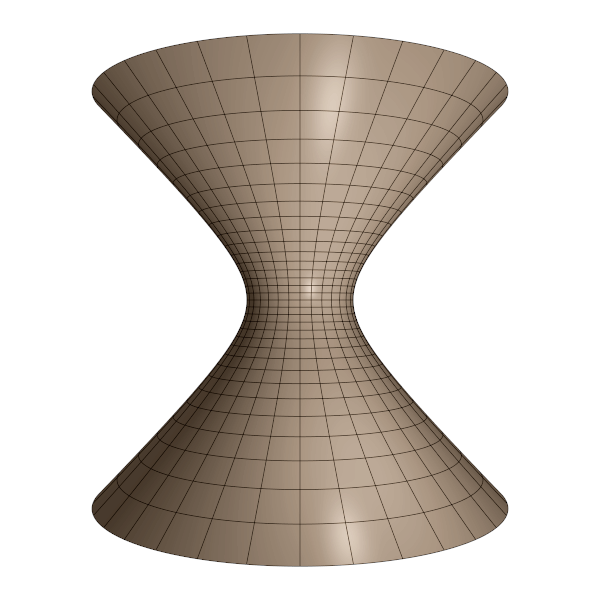Parabola
Object type: Plane curve
Definition
In $\mathbb{R}^2$, a parabola is a set of points $(x, y)$ satisfying the equation $$y = ax^2 + bx + c$$ for some constants $a, b, c \in \mathbb{R}$ with $a \neq 0$, that is, the parabola is the graph of the function $x \mapsto ax^2 + bx + c$. Below the parabola $y = x^2$ is shown.
The lowest point of the parabola is called its vertex, and the vertical line passing through this point is the axis of symmetry of the curve. Since $$a x^2 + bx + c = a \left(x + \frac{b}{2a}\right)^2 - \frac{b^2}{4a} + c,$$ the vertex is $\left(-b/2a, c - b^2/4a\right)$ and the axis of symmetry is $x = -b/2a$. Below we will only consider the parabola $y = a x^2$, since every other parabola (with axis of symmetry parallel to the vertical axis) can be obtained from this by translation.
Properties
Given a straight line $L \subset \mathbb{R}^2$ and a point $F \in \mathbb{R}^2$ with $F \not\in L$, the set of points equidistant to $L$ and $F$ is a parabola. Indeed, consider the line $y = -a$ and the point $(0, a)$. A point $(x,y) \in \mathbb{R}^2$ is equidistant to $L$ and $F$ iff $\sqrt{x^2 + \left(y - a\right)^2} = y + a$ which is equivalent to $y = x^2/4a$, which is a parabola. Conversely, every point on the parabola $y = a x^2$ is readily seen to be equidistant to the line $y = -1/4a$ and the point $(0, 1/4a)$. The line is called the directrix of the parabola, and the point is called the focus. Hence, there is a one-to-one correspondance between pairs (line, point (not on the line)) and parabolae in the plane.
Curvature
The curvature function for the parabola with vertex at the origin, that is, $y = a x^2$, parameterised using $x$ as parameter, is $$\kappa(t) = \frac{2 |a|}{\left(1 + 4 a^2 t^2\right)^{3/2}}.$$ Notice that the curvature is highest at the vertex.
Parabolae as Mirrors
A light-ray travelling towards a parabolic mirror parallel to its axis of symmetry will be reflected in the direction towards the focus, independent of where the ray hits the mirror. This makes parabolic mirrors very useful in technical applications. Below we compare a parabolic mirror with a circular mirror. The circular mirror fails to concentrate the light-rays to a single point.
(You might also experience a Hering illusion in the first picture.)
Proof of the focusing property of a parabolic mirror. Consider the parabola $y = a x^2$ and the particular light-ray $x = h > 0$ coming from above towards the parabola. This light-ray will hit the parabola at $(h, ah^2)$. Given the scalar field $F(x,y) = y - ax^2$, the parabola is the level curve $F(x, y) = 0$, and so its normal at $(h, ah^2)$ is the scalar field's gradient at this point, namely, $\mathbf{n} = (-2ah, 1)$. Notice that the normal points upwards. Let $\alpha$ be the angle between the vertical direction $\hat{\mathbf{y}} = (0,1)$ and $\mathbf{n}$. Since $$\left\langle\mathbf{n}, \hat{\mathbf{y}}\right\rangle = 1 = \sqrt{4a^2h^2 + 1} \cos{\alpha},$$ we have $$\alpha = \arccos{\frac{1}{\sqrt{4a^2h^2 +1}}}.$$ Notice that $\alpha$ is the angle between the normal of the reflecting line and the incoming light-ray. By the law of reflection, this angle is the same as the angle between the normal and the reflected line. Thus the angle between the vertical direction $\hat{\mathbf{y}}$ and the reflected line is $x := 2\alpha$. Let $F_h$ denote the intersection of the reflected line with the $y$-axis $x = 0$.
Consider now the reflected line $y = kx + m$. Let $\Delta x := h > 0$ and $\Delta y < 0$ be the change in $x$ and $y$, respectively, on the reflected line from $x = 0$ to the point of reflection at $x = h$. Since $\Delta x$ and $-\Delta y$ are the lengths of the catheti of the right triangle with vertices at $F_h$, $F_h + h \mathbf{\hat{x}}$, and $(h, ah^2)$, we have $$\frac{\Delta x}{-\Delta y} = \tan{x} = \tan{2\arccos{\frac{1}{\sqrt{4a^2 h^2 + 1}}}} = \frac{4ah}{1 - 4a^2 h^2},$$ as is readily verified using elementary trigonometry. Thus, $$k := \frac{\Delta y}{\Delta x} = \frac{4 a^2 h^2 -1}{4ah}.$$ Since $(h, ah^2)$ lies on the reflected line, $$m = ah^2 - \frac{4a^2 h^2 - 1}{4ah} h.$$ Therefore, the reflected line is $$y = \frac{4a^2 h^2 - 1}{4ah} x + ah^2 - \frac{4a^2 h^2 - 1}{4a}.$$ Putting $x=0$ yields $y = 1/4a$; consequently, $$F_h = \left(0, \frac{1}{4a}\right),$$ which remarkably does not depend upon $h$. Hence, every incoming ray of light (parallel to the axis of symmetry) will pass through $(0, 1/4a)$ after reflection, and we recognise this point as the focus of the parabola. ∎
Other Examples
- A body (such as a ball) thrown at the surface of the Earth (or in any other constant field of gravity) will follow a parabolic trajectory if non-gravitational influence is neglected (such as air resistance).
- The so-called 'velocity profile' in fully-developed Poiseuille flow of a Newtonian fluid in a straight circular cylindrical tube is parabolic. More precisely, if the (dynamic) viscosity of the fluid is $\mu$ and the constant radius of the tube is $R$, then, in cylindrical coordinates $(r, \varphi, z)$ where the tube is $r = R$, the velocity of flow at $(r, \varphi, z)$ inside the tube is $\mathbf{v} = -\frac{k}{4\mu}(R^2-r^2)\mathbf{\hat{z}}$ where $k$ is the pressure gradient.
